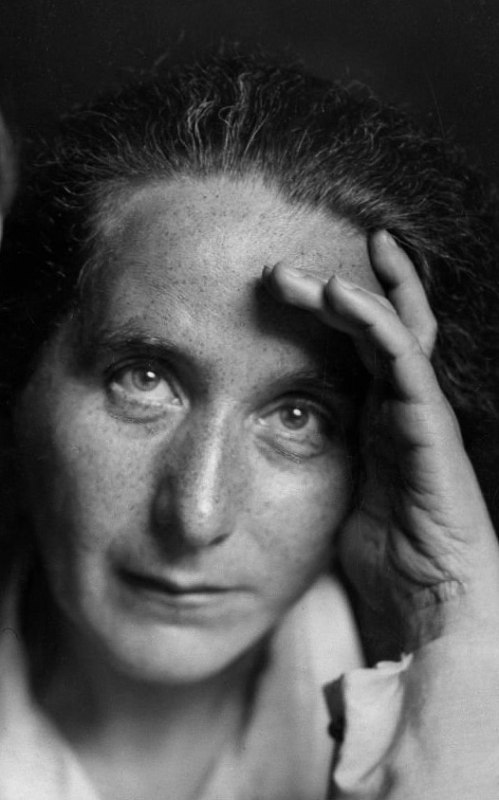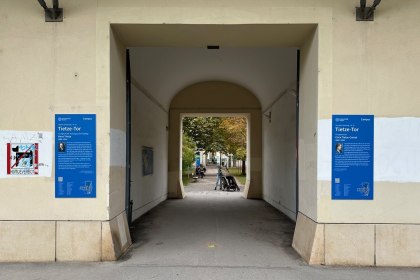Erica Tietze-Conrat, Dr. phil.
First female art historian to receive a doctorate from the University of Vienna (1905)
Honors
| Ehrung | Titel | Datierung | Fakultät | |
|---|---|---|---|---|
| Monument for Art Historians | 2008/09 | Faculty of Historical and Cultural Studies |
|
|
| Gate of Remembrance | Tietze Gate | 2023/24 | Faculty of Historical and Cultural Studies |
In November 2023, the Senate of the University of Vienna decided to honor Erica Tietze-Conrat for her achievements in the field of art history and her husband Hans Tietze for his scientific achievements in the field of art history, monument preservation and museum reorganization by naming this „Gate of Remembrance“ after both of them as part of the redesign of the „Gates of Remembrance“. |
- Art History
- Faculty of Philosophy
Erica Conrat was born in 1883 as the youngest child of the merchant and music lover Hugo Conrat, née Cohn (1845–1906, name changed to Conrat in 1882) and Ida Conrat, née Kohn (1857–1938), into an upper middle-class, art-loving, assimilated Jewish family in Vienna who had converted to Protestantism. She and her two sisters (sculptor Ilse von Twardowski-Conrat (1880–1942) and Felicia Fränkel (1881–after 1955)) received a good education – she graduated from the Hanausek-Stonner Girls' Teaching and Educational Institute and the girls' grammar school in Vienna 1, Hegelgasse, where she also passed her school-leaving examination (Matura) in 1901.
From 1900, women were admitted to the Faculty of Philosophy at the University of Vienna, so from 1901 she was able to study archaeology and art history there, the latter under the protagonists of the Viennese School of Art History, Alois Riegl and Franz Wickhoff. On December 20th, 1905, she became the first woman to receive a doctorate in art history from the University of Vienna (dissertation: „Contributions to the History of Georg Raphael Donner“).
Shortly before this, she had married her former fellow student Hans Tietze (1880–1954), who had already received his doctorate in 1903, and in 1907 they moved into the house built for them by architect Hartwig Fischel at Armbrustergasse 20 in Vienna 19. They had four children together: Christopher Tietze (1908–1984, doctor and demographer), Andreas Tietze (1914–2003, professor of Turkology), Walburg Rusch (1915–2011, graphic artist) and Veronica Tietze (1918–1927).
She taught at the Vienna Urania and other popular education institutions and was a freelancer at the Albertina Graphic Collection. After a serious illness in 1921, she began to write poetry, tried her hand at a novel, wrote eight plays and 15 short stories. Above all, she published numerous specialist articles and exhibition reports since completing her doctorate, was a proven expert on Austrian Baroque and Classicist sculpture and later shifted her expertise to Italian Renaissance art. She also worked and published extensively together with her husband, who had already habilitated in 1908, including 12 volumes of the Österreichische Kunsttopographie from 1906 to 1911.
Erica Tietze-Conrat was not only an art historian, but also a collector with numerous representatives of international museums, art scholars, collectors, dealers and contemporary artists in Vienna and internationally. She and her husband were friends with numerous contemporary artists: Oskar Kokoschka painted the famous double portrait in 1909 (Museum of Modern Art, New York), the sculptor Georg Ehrlich created bronze busts of Erica Tietze as well as of Hans Tietze (Österreichische Galerie Belvedere, Vienna) and numerous portrait drawings, but Joseph and Mimi Floch, Alma Mahler, Alexander von Zemlinsky and Arnold Schönberg also belonged to their circle of friends. The Tietzes actively promoted contemporary artists in their publications, helped with exhibitions and museum acquisitions and also repeatedly purchased works of art themselves, thereby creating a considerable art collection.
Her husband received the title, but not the position, of Associate Professor of Art History at the University of Vienna in 1919 and played a central role between 1900 and 1925, not only in art historical research and monument protection, but also in the retention („defence“) of the Habsburg art holdings in Austria after the end of the First World War and in their reorganization and „exploitation“ in terms of democratic policy. From 1919 to 1926, as a ministerial councillor in the Ministry of Education, he attempted to bring together the previously competing former imperial and state collections and museums, to reorganize and nationalize them and, in doing so, to open up and democratize them in terms of educational policy, but after initial successes he failed due to conservative resistance and resigned from the civil service in 1926.
Erica and Hans Tietze then completed a trip to Spain lasting several months, and their diaries, published in 2015, show that both of them had also given up their hopes of being able to contribute to a humanistic modernization of Austria in their fields. From 1935, she and her husband again undertook research and lecture tours in Europe and the USA and together they researched the major museums, private collections and archives and produced a complete work on Venetian drawings of the Renaissance. However, the research trips ended as an escape from National Socialism.
At the time of the Anschluss in 1938, they were in Italy and did not return to Austria, fleeing instead to Toledo, Ohio/USA in 1939 and living in New York from 1940. However, despite their high esteem and productivity, neither of them were able to find appropriate positions in the art and science scene there. In her (auto-)biographical report „Hans Tietze. March 1st, 1880–April 11, 1954“ (Nachlass Wien Bibliothek), she describes the painfully felt social decline that exile brought for both of them, which was even more noticeable in the case of her husband, the former Austrian court councillor and university professor. They had to sell the double portrait by Kokoschka they had saved during their emigration in New York in 1939 in order to earn a living with the proceeds – a photo from Christmas 1944 shows the couple sitting at a table with only a photograph of the valuable painting in front of them. After her husband's death in 1954, she at least managed to teach at Columbia University in New York until 1956.
Erica Tietze-Conrat died in New York in 1958.
Honors
In 2004, an International Hans Tietze and Erica Tietze-Conrat Society was founded in Vienna in order to preserve her oeuvre.
In 2008, her name was entered on the Memorial to the Marginalized, Emigrated and Murdered of the Institute of Art History of the University of Vienna on the campus of the University of Vienna, Hof 9, and in 2009 in the Memorial Book for the Victims of National Socialism at the University of Vienna 1938.
A partial estate has been accessible in the Vienna Library since 2014. In 2015, a memorial plaque was unveiled at their former home in Vienna 19 and the newly built print rooms of the Albertina Collection of Prints and Drawings were named after the Tietze couple („Tietze Galleries for Prints and Drawings“).
As part of the redesign of the „Gates of Remembrance“ on the campus of the University of Vienna in 2023/24, it was decided in November 2023 to name the gate between Courtyard 3 and Courtyard 13 „Tietze Gate“ after her and her husband.
Works (selection)
- Unknown works by G. R. Donner, in: Jahrbuch der k. k. Zentral-Kommission für Erforschung und Erhaltung der kunst- und historischen Denkmale, N.F. 3, 2nd T., Vienna 1905.
- The art of women. An epilogue to the exhibition at the Vienna Secession. In: Journal of Fine Arts. New series. Volume 22, 1911, pp. 146–148.
- Die Linearkomposition bei Tizian, in: Kunstgeschichtliche Anzeigen, H. 3/4, Vienna 1915.
- Die Bronzen der fürstlich Liechtensteinschen Kunstkammer, in: Jahrbuch des kunsthistorischen Instituts der k. k. Zentralkommission für Denkmalpflege, vol. 11, Vienna 1917.
- Austrian Baroque sculpture. Vienna 1920.
- Die Erfindung im Relief, ein Beitrag zur Geschichte der Kleinkunst, in: Jahrbuch der kunsthistorischen Sammlungen, vol. 35, Vienna 1920.
- Oskar Laske. Vienna 1921.
- The Utrecht Psalter, Vienna 1921.
- Andrea Mantegna (Library of Art History 51). Leipzig 1923.
- The French copperplate engraving of the Renaissance. Munich 1925.
- Farewell (Poems). Etchings by Georg Ehrlich, 1926.
- Together w. Hans Tietze: Domenico Campagnola's graphic art, London 1926.
- together w. Hans Tietze: Kritisches Verzeichnis der Werke Albrecht Dürers 1, Der junge Dürer (Verzeichnis der Werke bis zur venezianischen Reise im Jahre 1505), Augsburg 1928.
- Together with. Hans Tietze: Kritisches Verzeichnis der Werke Albrecht Dürers 2.1, Der reife Dürer (Von der venezianischen Reise im Jahre 1505 bis zur niederländischen Reise im Jahre 1520 nebst Nachrägen aus den Jahren 1492–1505), Basel et al. 1937.
- Together with. Hans Tietze: Kritisches Verzeichnis der Werke Albrecht Dürers 2.2, Der reife Dürer (Von der niederländischen Reise im Jahre 1520 bis zum Tode des Meisters 1528), Basel et al. 1938.
- Together with. Hans Tietze: The Drawings of the Venetian Painters in the 15th and 16th Centuries. New York 1944 (²1970, ³1979).
- Mantegna. Paintings, Drawings, Engravings. London 1955.
- Georg Ehrlich. London 1956.
- Dwarfs and Jesters in Art. London 1957.
- „I then asked myself: what is the 'Viennese School'?“ Memories of the Years of Study in Vienna [1958], in: Wiener Jahrbuch für Kunstgeschichte. 59, 2011, 207–218
- Diaries. 3 volumes. Edited by Alexandra Caruso, Böhlau, Vienna 2015.
Archive of the University of Vienna, Rigorosenakt PH RA 1962, graduation registry PHIL III (1905–1912) No. 38
Zuletzt aktualisiert am 02/21/25


